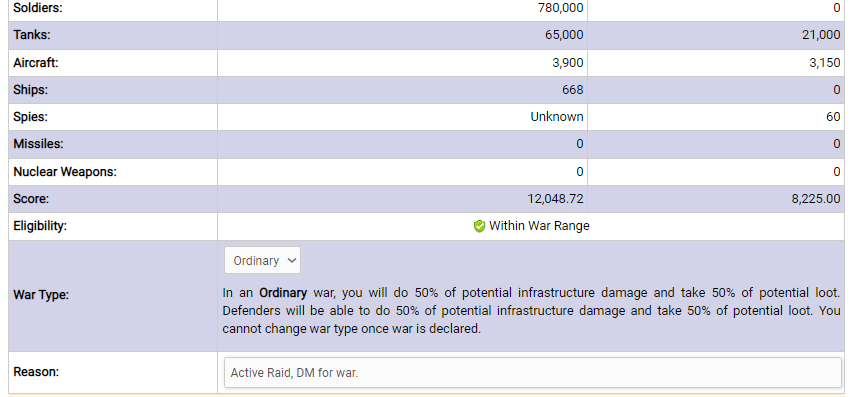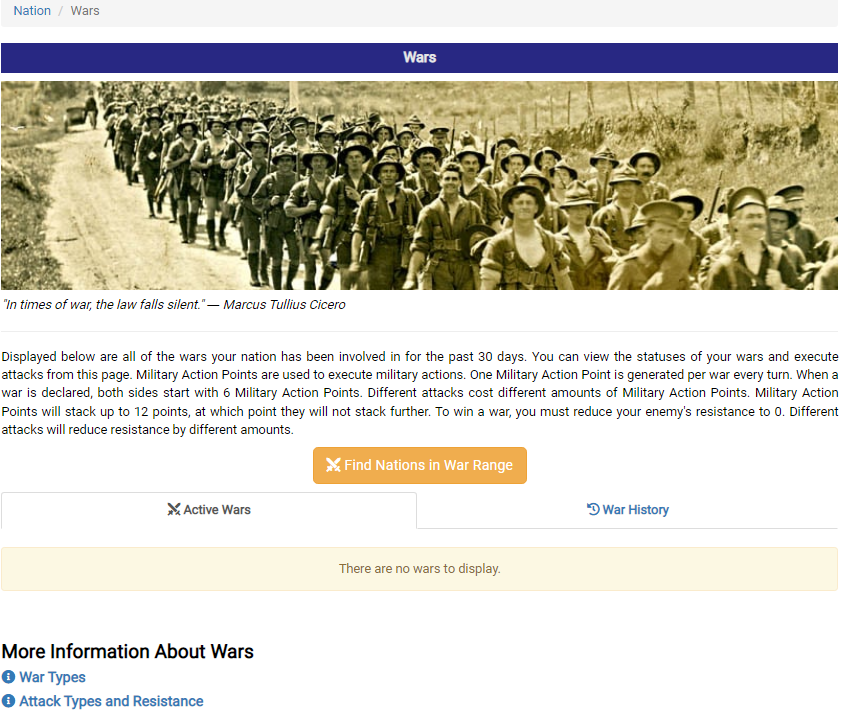Now that you’ve gotten yourself acquainted with the game, you need to make money. At the start, the best way this can be done is by attacking other nations for their resources.
Attacking other nations is called “raiding”, and this is done by attacking a nation within your range to take their resources. But just as you can attack them, they can also attack you. Make sure your troops are trained and your military improvements are sufficient for your level of readiness.
Attacking in war can be done by land, air, or sea. And each costs a certain number of MAPs (Military Action Points). You normally start the war with 6 MAPs, 5 MAPs or 7 MAPs can be possible based on your opponent’s war policy and earn 1 MAP per turn and you can only possess a maximum of 12 MAPs.

Declaring war on a nation, you choose three types – Ordinary, Attrition and Raid. Ordinary is the moderate option, you do 50% of potential infrastructure damage and take 50% of possible loot, whereas in Attrition you do 100% of potential infrastructure damage and take 25% of possible loot, and Raid is the opposite of Attrition with 25% potential infrastructure damage and take 100% of possible loot. Once the war type is chosen you can’t change it. Each side has 100% resistance, the first nation to zero resistance losses. There are different actions you can take in war:
- 5 offensive actions – Ground Battle, Airstrike, Naval Battle, Launch Missile and a Nuclear Attack
- 1 defensive action – Fortify (3 MAPs)
- Espionage uses your spies, which is limited to one espionage attack per day, and doesn’t affect resistance or MAPs
- Offer peace – this is done if the war is to conclude with no victor and peacefully
There are various scales of success in your military offensive attacking – Immense triumph (IT), Moderate success (MS) and Pyrrhic victory (PV)– this affects the amount of resistance you reduce per form of action; an Utter Failure (UT) is a complete loss and does not change any resistance levels.

The following table illustrates this amount of resistance lost based on each level of success:
Type of attack | MAPs | Immense Triumph | Moderate Success | Pyrrhic Victory |
Ground Battle | 3 | 10 | 7 | 4 |
Airstrike | 4 | 12 | 9 | 6 |
Naval Battle | 4 | 14 | 11 | 8 |
Missile | 8 | 18* | ||
Nuclear Attack | 12 | 25* | ||
*Missile and Nuclear attack deal 18 and 25 regardless
If an immense triumph is achieved, it creates a certain level of control for either air, land, or sea attacks:
- Ground Control is achieved through an IT from a ground attack, and ground control then allows the subsequent ground attacks to destroy a percentage of the opponent’s planes.
- Air Superiority is achieved through an IT from an airstrike, and this reduces the opponent to 50% of his tank capacity.
- Blockade is achieved through an IT from a naval strike and prevents the nation from transferring cash and/or resources into or out of their nation.
- Fortify is the option to fortify the nation and your opponent takes 25% more casualties when attacking. Fortify ends when you perform any attack.
You can declare war on 5 nations, 6 with the Pirate Economy Project, and have 3 wars declared on you.
Warring is determined by your war range, which is determined by your nation’s score. Your nation score is used to determine how strong your nation is. Everyone can view this on your nation page. Your nation’s score is determined by considering several factors – cities, infrastructure, projects, and military. Your war range is then from 25% below your nation’s score to 75% above it. This is done to protect small nations from being attacked by much larger nations. It helps to prevent mismatches in war.
Once you’ve earned yourself a nice amount of money and resources, you’re set to grow!
